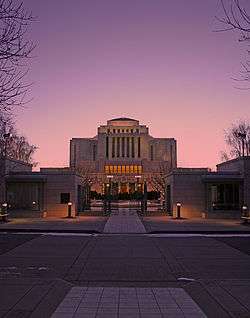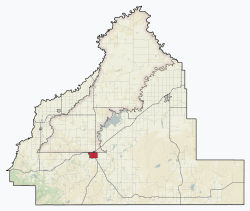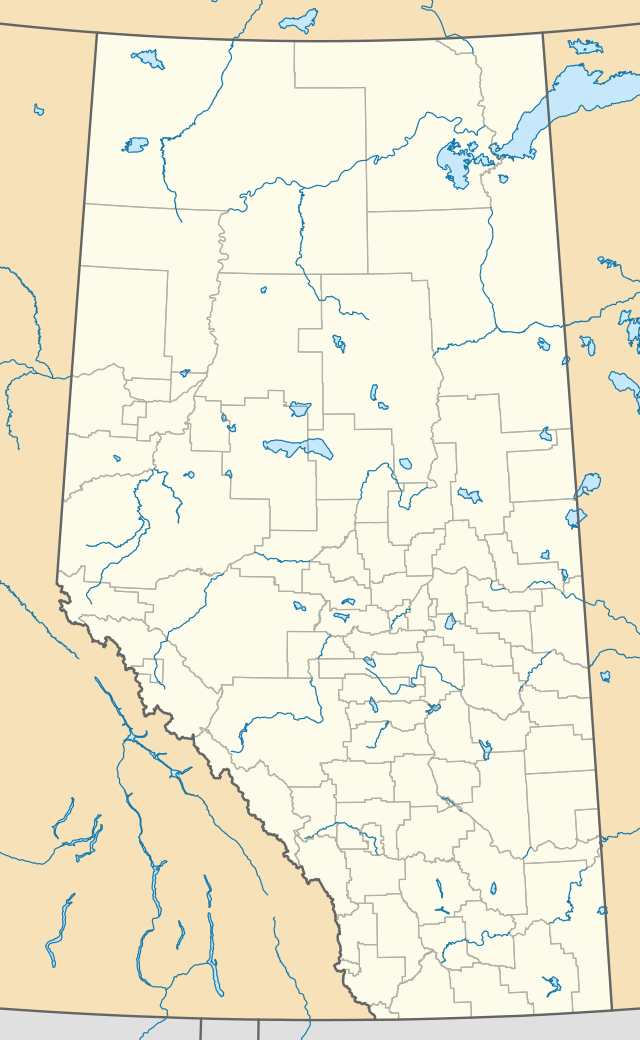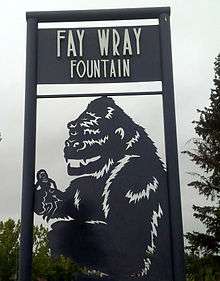Cardston
Cardston is a town in Alberta, Canada. The land on which Cardston was founded was originally inhabited by the Niitsitapi (Blackfoot) people of Kainai but was not considered part of Blackfoot Territory by the Government of Canada in the Treaty 7 agreement of 1877.[6]
Cardston | |
|---|---|
Town | |
| Town of Cardston | |
 | |
| Nickname(s): c town | |
 Location in Cardston County | |
 Cardston Location of Cardston in Alberta | |
| Coordinates: 49°12′09″N 113°18′07″W | |
| Country | Canada |
| Province | Alberta |
| Region | Southern Alberta |
| Planning region | South Saskatchewan |
| Municipal district | Cardston County |
| Incorporated[1] | |
| • Village | December 29, 1898 |
| • Town | June 2, 1901 |
| Government | |
| • Mayor | Maggie Kronen |
| • Governing body | Cardston Town Council |
| • MP | Glen Motz |
| • MLA | Joseph Schow |
| Area (2016)[3] | |
| • Land | 8.59 km2 (3.32 sq mi) |
| Elevation | 1,130 m (3,710 ft) |
| Population (2016)[3] | |
| • Total | 3,585 |
| • Density | 417.5/km2 (1,081/sq mi) |
| • Municipal census (2018) | 3,909[5] |
| Time zone | UTC-7 (MST) |
| • Summer (DST) | UTC-6 (MDT) |
| Area code(s) | 403, 587, 825 |
| Highways | |
| Waterway | Lee Creek St. Mary River St Mary Reservoir |
| Website | Official website |
Cardston was established in 1887 by members of The Church of Jesus Christ of Latter-day Saints who travelled from Utah, via the Macleod-Benton Trail, to Alberta in one of the century's last wagon migrations.[7] The founder of the town was Charles Ora Card. The combined church and school was completed by January 29 the following year after their arrival.[8]
Cardston has been a "dry" (alcohol free) town for 115 years, and there are no licensed premises in which to use video lottery terminals.[9] In 1951, 75% of Cardston's 3500 residents were members of the Church of Latterday Saints.[10] It remains at about 80%, as of 2014.[9]
Geography
Cardston is situated in the foothills of southwest Alberta, approximately 25 km (15.53 mi) north from the American state of Montana. On its north side, it borders the Kainai Nation (Blood Tribe) Reserve, one of the largest reserves in North America. 40 km (24.85 mi) to the west of Cardston are the Rocky Mountains of Waterton Lakes National Park. Cardston is 77 km (47.85 mi) southwest of Lethbridge and 234 km (145.40 mi) south of Calgary.
- Coordinates: 49°12′09″N 113°18′07″W
- Elevation: 1,130 m (3,710 ft)
- Land Area (square kilometers): 8.59 km2 (3.32 sq mi)
Demographics
In the 2016 Census of Population conducted by Statistics Canada, the Town of Cardston recorded a population of 3,585 living in 1,175 of its 1,270 total private dwellings, a 0.1% change from its 2011 population of 3,580. With a land area of 8.59 km2 (3.32 sq mi), it had a population density of 417.3/km2 (1,080.9/sq mi) in 2016.[3]
In the 2011 Census, the Town of Cardston had a population of 3,580 living in 1,208 of its 1,322 total dwellings, a 3.7% change from its 2006 population of 3,452. With a land area of 8.64 km2 (3.34 sq mi), it had a population density of 414.4/km2 (1,073.2/sq mi) in 2011.[11]
The population of the Town of Cardston according to its 2007 municipal census is 3,578.[12]In 2018, the Town of Cardston conducted a municipally ran census which resulted in a total population of 3,909.
| Age | Male | Female | Total |
|---|---|---|---|
| 0–4 | 115 | 140 | 255 |
| 5–14 | 335 | 310 | 645 |
| 15–19 | 175 | 180 | 355 |
| 20–24 | 105 | 100 | 205 |
| 25–34 | 125 | 160 | 285 |
| 35–44 | 175 | 210 | 385 |
| 45–54 | 165 | 200 | 365 |
| 55–64 | 125 | 155 | 280 |
| 65–74 | 135 | 170 | 305 |
| 75+ | 150 | 260 | 410 |
| Totals | 1600 | 1870 | 3470 |
Source: Statistics Canada 2001 Census (numbers may not add up due to rounding)
| 1996 | 2001 | |
|---|---|---|
| Total number of families | 730 | 760 |
| Average family income | $53,750 | $52,939 |
| Median family income | $46,503 | $48,004 |
Source: Statistics Canada 1996 & 2001 Census
Climate
Cardston experiences a humid continental climate (Köppen climate classification Dfb). Along with the rest of southern Alberta, Cardston is subject to chinooks, which often bring temperatures in mid-winter well above 10 °C (50 °F). This same pattern results in more than 200 days of wind a year.
Weather records:[13]
- Hottest Temperature: 39.0 °C (102.2 °F) on 23 July 2007[14]
- Coldest Temperature: −41.7 °C (−43 °F) on 28 January 1929
- Most Rain In One Day: 106.0 mm (4.17 in) on 6 June 1995
- Most Snow In One Day: 63.5 cm (25.0 in) on 4 May 1919
- Deepest Snow Cover: 84 cm (33.1 in) on 29 April 1967
| Climate data for Cardston, 1981–2010 normals, extremes 1918–present | |||||||||||||
|---|---|---|---|---|---|---|---|---|---|---|---|---|---|
| Month | Jan | Feb | Mar | Apr | May | Jun | Jul | Aug | Sep | Oct | Nov | Dec | Year |
| Record high °C (°F) | 19.0 (66.2) |
21.0 (69.8) |
24.5 (76.1) |
30.5 (86.9) |
33.0 (91.4) |
35.6 (96.1) |
39.0 (102.2) |
36.7 (98.1) |
34.5 (94.1) |
29.5 (85.1) |
23.9 (75.0) |
19.4 (66.9) |
39.0 (102.2) |
| Average high °C (°F) | 1.4 (34.5) |
2.5 (36.5) |
5.9 (42.6) |
11.5 (52.7) |
16.5 (61.7) |
20.5 (68.9) |
24.5 (76.1) |
24.8 (76.6) |
19.0 (66.2) |
12.8 (55.0) |
4.5 (40.1) |
1.1 (34.0) |
12.1 (53.8) |
| Daily mean °C (°F) | −4.5 (23.9) |
−3.5 (25.7) |
−0.1 (31.8) |
5.1 (41.2) |
9.9 (49.8) |
13.8 (56.8) |
16.9 (62.4) |
16.9 (62.4) |
11.8 (53.2) |
6.3 (43.3) |
−1.1 (30.0) |
−4.6 (23.7) |
5.6 (42.1) |
| Average low °C (°F) | −10.4 (13.3) |
−9.5 (14.9) |
−6.1 (21.0) |
−1.3 (29.7) |
3.3 (37.9) |
7.0 (44.6) |
9.3 (48.7) |
8.9 (48.0) |
4.6 (40.3) |
−0.2 (31.6) |
−6.7 (19.9) |
−10.3 (13.5) |
−1.0 (30.2) |
| Record low °C (°F) | −41.7 (−43.1) |
−38.9 (−38.0) |
−36.7 (−34.1) |
−25.6 (−14.1) |
−12.8 (9.0) |
−5.6 (21.9) |
−0.5 (31.1) |
−3.9 (25.0) |
−15.6 (3.9) |
−26.5 (−15.7) |
−35.6 (−32.1) |
−38.5 (−37.3) |
−41.7 (−43.1) |
| Average precipitation mm (inches) | 20.8 (0.82) |
19.1 (0.75) |
37.5 (1.48) |
40.6 (1.60) |
81.3 (3.20) |
90.7 (3.57) |
45.5 (1.79) |
43.9 (1.73) |
53.1 (2.09) |
31.6 (1.24) |
29.6 (1.17) |
21.5 (0.85) |
515.0 (20.28) |
| Average rainfall mm (inches) | 0.4 (0.02) |
0.0 (0.0) |
1.5 (0.06) |
10.8 (0.43) |
66.7 (2.63) |
90.7 (3.57) |
45.5 (1.79) |
43.7 (1.72) |
49.2 (1.94) |
9.9 (0.39) |
2.1 (0.08) |
0.1 (0.00) |
320.6 (12.62) |
| Average snowfall cm (inches) | 20.4 (8.0) |
19.1 (7.5) |
36.0 (14.2) |
29.7 (11.7) |
14.6 (5.7) |
0.0 (0.0) |
0.0 (0.0) |
0.1 (0.0) |
3.6 (1.4) |
21.7 (8.5) |
27.4 (10.8) |
21.4 (8.4) |
194.2 (76.5) |
| Source: Environment Canada[13][14][15] | |||||||||||||
Economy
Primary industries are education, health care, entrepreneurship, agriculture, and tourism.[16] Cardston is one of the few communities in Canada where alcohol cannot be sold or purchased.[17][18]
Attractions
Cardston has a soccer park, ball parks, a golf course, an ice skating rink, a swimming pool, tennis courts, hiking trails, a skateboard park, several recreation parks, picnic areas and playgrounds. St. Mary's Dam reservoir northeast of Cardston supports water sports in the summer months.
Local attractions
- Cardston Alberta Temple
- The Cardston Alberta Temple is Cardston's most recognized landmarks. It was constructed by Mormon pioneers. Built in 1923, it was the first temple constructed by the Church of Jesus Christ of Latter-day Saints outside of the United States.[19] It remained the only temple in Canada until the Toronto Ontario Temple was built in 1990.
- Remington Carriage Museum
- The Remington Carriage Museum houses the largest collection of horse-drawn vehicles in North America, with more than 250 carriages, wagons and sleighs. The 63,000-square-foot (5,900 m2) facility features video displays, a fire hall, carriage factory, restoration shop, working stable, carriage rides, carriage rentals, a restaurant, and a gift shop. Guided tours are offered for free. On April 9, 2006, the museum was briefly mentioned on TV in Canada as a destination of Patty and Selma's vacation during the Kiss Kiss, Bang Bangalore episode of The Simpsons.
- The Carriage House Theatre
- This theatre was constructed in 1912 by Mark Spencer, and underwent renovations in 1937 and 1992. It seats 350 and hosts films, community theatre and professional summer theatre, which has produced such shows as Seussical, Oklahoma, and Joseph and the Amazing Technicolor Dreamcoat.
- Card Pioneer Home
- A genuine "Little House on the Prairie", it was built by Cardston's founder Charles Ora Card in 1887, and served as a community centre and stopping place for travellers until the first hotel was built in 1894. The log structure stands in its original location and is open for public visits as a Registered Provincial Historic site. Card Home
- Courthouse Museum
- The Courthouse Museum shows how a rough country changed dramatically. The unique sandstone structure was built in 1907 from stone quarried near Cardston. The building's profile and interior stand as a monument to Cardston's early pioneer artisans. It was used longer than any other courthouse in Alberta. The building displays the judge's bench, witness box, and other artifacts. Original jail cells, including graffiti, can be found. The Courthouse Museum is a Registered Provincial Historic site, Courthouse Museum
Regional attractions
- Waterton Lakes National Park
Waterton Lakes National Park is a national park in the southwest corner of Alberta, 40 km (25 mi) west of Cardston, and borders Glacier National Park in Montana, USA. Waterton Lakes was Canada's fourth national park, formed in 1895. Amid the peaks are the lakes of Waterton Lakes National Park, carved out of the rock by glaciers.
- Frank Slide Interpretive Centre
On April 29, 1903, at 4:10 a.m., the mining town of Frank, Alberta, was devastated by 82 million tonnes of limestone crashing down from Turtle Mountain. The Frank Slide Interpretative Centre in the Crowsnest Pass, 130 km (81 mi) northwest of Cardston, tells of one of the greatest natural disasters in Canadian history.
- Castle Mountain Ski Resort
Castle Mountain Resort 90 km (56 mi) west of Cardston has kilometres of groomed skiing runs, natural half pipes, deep fresh powder, short lift lines and wide open spaces.
- Writing On Stone Provincial Park
Writing-on-Stone Provincial Park, 125 km (78 mi) east of Cardston, is one of the largest areas of protected prairie in the Alberta park system, a nature preserve and protection for rock art created by Plains People. There are 50 rock art sites, with thousands of figures, as well as archaeological sites.
- Police Outpost Provincial Park
Police Outpost Provincial Park is 32 kilometres (20 mi) south of Cardston, on the Canada/United States border, on the shores of Outpost Lake.
Education
Schools include the Cardston High School, the Cardston Jr. High School (formerly Eastridge Elementary School), and Cardston Elementary School which are all under the Westwind School Division.
Former schools include Leeside (grades 1 and 2 - torn down in the late 1980s to make way for the Remington-Alberta Carriage Centre) and Westside. The building that housed many of the junior high facilities, E.J. Wood School (including the gymnasium near the current high school), Parkland School, and John S. Smith Schools were torn down in 1993 as the junior high moved to the former Eastridge building. The Cardston High School underwent extensive renovations in the early 2000s, including an expansion to its gymnasium, much-improved fitness and weight room facilities, wider hallways, and a new cafeteria.
Media
- Historical newspapers
- The Cardston News was first published in 1924 and was a weekly until 1925. During 1924–1925, the newspaper was edited and published by Fred Burton. It was later taken over by D.O. Wight, editor and managing director from September 17, 1925 until June 9, 1936. Fred Burton took over as publisher on June 16, 1936. The Cardston News was taken over by Gordon F. West On May 7, 1964.[20]
- The Cardston Record began publication on August 6, 1898 and was published weekly until September 1901.[20]
The Cardston News (1928-1958) and Cardston Record (1898-1899) have been digitized from microfilm and are available through the University of Lethbridge Library digitized collections. Also look at what the Cardston Historical Society has on their website Archives
Notable people

- Victor L. Brown, world leader in the LDS Church[21]
- Ben Cahoon, CFL slotback who won three Grey Cup championships with the Montreal Alouettes.
- Elaine L. Jack, world leader in the LDS Church[22]
- Merlin R. Lybbert, world leader in the LDS Church[23]
- Shawna Molcak, Basketball player who played for Canada in the 1996 Summer Olympics[24]
- Grant Strate, dancer and choreographer[25]
- Edward J. Wood, leader in the LDS Church[26]
- George Woolf, jockey
- Fay Wray, actress[27]
See also
References
- "Location and History Profile: Town of Cardston" (PDF). Alberta Municipal Affairs. October 7, 2016. p. 120. Retrieved October 13, 2016.
- "Municipal Officials Search". Alberta Municipal Affairs. September 22, 2017. Retrieved September 25, 2017.
- "Population and dwelling counts, for Canada, provinces and territories, and census subdivisions (municipalities), 2016 and 2011 censuses – 100% data (Alberta)". Statistics Canada. February 8, 2017. Retrieved February 8, 2017.
- "Alberta Private Sewage Systems 2009 Standard of Practice Handbook: Appendix A.3 Alberta Design Data (A.3.A. Alberta Climate Design Data by Town)" (PDF) (PDF). Safety Codes Council. January 2012. pp. 212–215 (PDF pages 226–229). Retrieved October 8, 2013.
- "Municipal Census Results". Retrieved September 21, 2018.
- "Blood Tribe wins massive land claim battle in Federal Court".
- Cardston Diamond Jubilee Committee (1962). Cardston jubilee : 1887-1962 : Jubilee Souvenir. p. 28. Archived from the original on 2017-03-03. Retrieved 2013-06-10.
- Shaw, Keith (1978). Chief mountain country : a history of Cardston and district. Volume I. Cardston: Cardston and District Historical Society. p. 45. ISBN 0-919213-89-8. Archived from the original on 2015-09-24. Retrieved 2013-06-13.
- News; Canada (2014-10-07). "Mayor of Cardston, Alberta, says 'party animal' citizens don't need alcohol in dry town | National Post". Retrieved 2020-02-03.
- Lawrence, Richard (January 15, 1951). "The Sober Truth About the Mormons". Maclean's.
- "Population and dwelling counts, for Canada, provinces and territories, and census subdivisions (municipalities), 2011 and 2006 censuses (Alberta)". Statistics Canada. 2012-02-08. Retrieved 2012-02-08.
- Alberta Municipal Affairs (2009-09-15). "Alberta 2009 Official Population List" (PDF). Retrieved 2010-09-14.
- "Cardston, Alberta". Canadian Climate Normals 1981–2010 (in English and French). Environment Canada. 2013-09-25. Retrieved March 10, 2014.
- "July 2007". Canadian Climate Data (in English and French). Environment Canada. 2011-10-31. Retrieved 20 May 2016.
- "January 2015". Canadian Climate Data (in English and French). Environment Canada. Retrieved 20 May 2016.
- "Statistics Canada. 2017. Cardston County, MD [Census subdivision]". Census Profile. 2016 Census. Released November 29, 2017. Retrieved February 3, 2020. Check date values in:
|date=(help) - "CBC News". CBC. 2014-10-06. Retrieved 2020-07-30.
- Cardston, ULethbridge Digital Collection
- Strathern, Gloria M. (1988). Alberta Newspapers, 1880-1982: An Historical Directory Archived 2011-06-14 at the Wayback Machine. University of Alberta. pp. 56. ISBN 0-88864-137-0.
- “Elder Victor L. Brown Dies at 81,” Ensign, May 1996, 105.
- “Elder Merlin R. Lybbert of the Second Quorum of the Seventy,” Ensign, May 1989, 98.
- "Shawna Molcak," Olympic.ca/athletes, Retrieved July 27, 2020.
- "Strate, Grant", The Canadian Encyclopedia, accessed 2007-12-17.
- Jay M. Todd, “Edward J. Wood: ‘Faith Personified’,” Ensign, September 1988, 50.
- William Addams Reitwiesner, Ancestry of Fay Wray, accessed 2007-12-17.